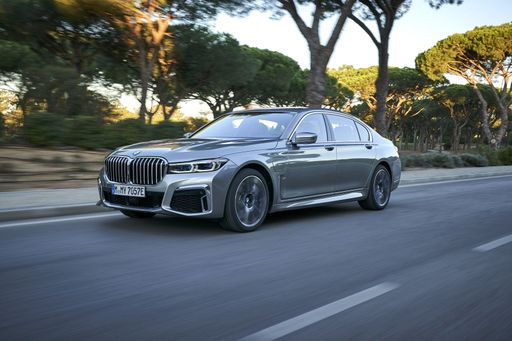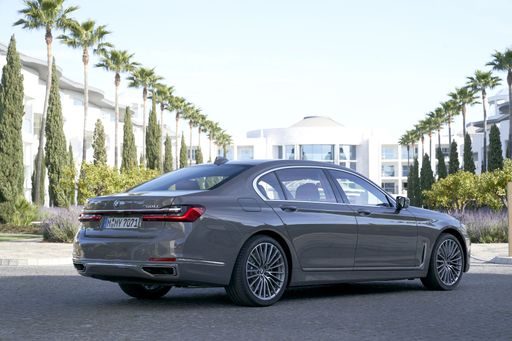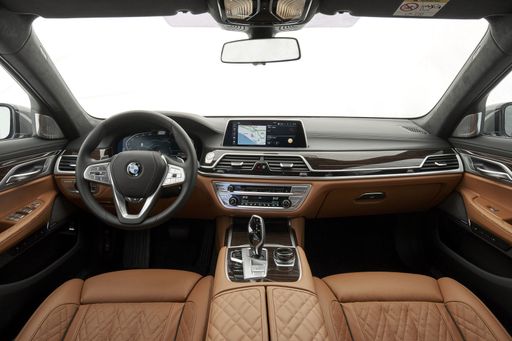BMW 7 Series vs Rolls-Royce Ghost – Differences & prices compared
Compare performance, boot space, consumption and price in one view.
Find out now: which car is the better choice for you – BMW 7 Series or Rolls-Royce Ghost?
The BMW 7 Series (Sedan) comes with a Plugin Hybrid or Diesel MHEV engine and Automatic transmission. In comparison, the Rolls-Royce Ghost (Sedan) features a Petrol MHEV engine with Automatic transmission.
When it comes to boot capacity, the BMW 7 Series offers 540 L, while the Rolls-Royce Ghost provides – depending on how much space you need. If you’re looking for more power, decide whether the 571 HP of the BMW 7 Series or the 571 HP of the Rolls-Royce Ghost suits your needs better.
In terms of consumption, the values are 1 L per 100 km for the BMW 7 Series, and 15 L for the Rolls-Royce Ghost.
Price-wise, the BMW 7 Series starts at 101500 £, while the Rolls-Royce Ghost is available from 248600 £. Compare all the details and find out which model fits your lifestyle best!
In the realm of luxury sedans, the BMW 7 Series and the Rolls-Royce Ghost stand out as icons of opulence, yet they cater to distinct tastes. The BMW 7 Series is celebrated for its precision engineering and cutting-edge technology, providing a dynamic driving experience with luxurious comfort. Meanwhile, the Rolls-Royce Ghost epitomizes ultimate luxury and bespoke craftsmanship, offering an unparalleled sense of exclusivity and an aura of regal elegance unmatched in the automotive world.
BMW 7 Series
The BMW 7 Series represents the pinnacle of luxury and performance in the executive car segment, offering an unparalleled driving experience. Its elegant design combines aesthetic appeal with advanced technology, ensuring both comfort and connectivity for its passengers. With cutting-edge driver assistance systems, this flagship model showcases the brand's commitment to innovation and safety.
details @ press.bmwgroup.com
@ press.bmwgroup.com
 @ press.bmwgroup.com
@ press.bmwgroup.com
 @ press.bmwgroup.com
@ press.bmwgroup.com
 @ press.bmwgroup.com
@ press.bmwgroup.com
 @ press.bmwgroup.com
@ press.bmwgroup.com
 @ press.bmwgroup.com
@ press.bmwgroup.com
Rolls-Royce Ghost
The Ghost is a stunning representation of luxury and sophistication, embodying the essence of Rolls-Royce's craftsmanship. With its serene ride and opulent interior, it offers an unparalleled driving experience that envelops occupants in a world of comfort. Every detail, from the meticulously designed dashboard to the whisper-quiet engine, reflects the brand's commitment to excellence and elegance.
detailsElegance Meets Performance: BMW 7er Reihe vs Rolls-Royce Ghost
In the realm of luxury sedans, few names command the respect and admiration garnered by the BMW 7er Reihe and the Rolls-Royce Ghost. While both vehicles exude a refined opulence, they cater to discerning drivers in distinct ways. Here, we dive into the technical details and innovations that define these titans of luxury travel.
Design and Bodywork
The BMW 7er Reihe presents itself with a sleek yet commanding presence. At 5391 mm in length, it crafts a modern aesthetic that is both dynamic and stately. In contrast, the Ghost extends even longer, with dimensions ranging from 5546 mm to a staggering 5716 mm, signaling an expectation of royal treatment both inside and out.
While both vehicles share a four-door sedan format, the Ghost's more substantial dimensions emphasize its role as the chariot of choice for the world's elite. With a width of 2148 mm, it is broader than the 7er Reihe's 1950 mm, promising even more expansive luxury.
Power and Performance
The performance metrics of these luxury flagships tell a story of power paired with refinement. The BMW 7er Reihe offers a range of engine options, including diesel mild-hybrid and plug-in hybrid variants. With power outputs stretching up to 571 HP, the 7er Reihe impresses with acceleration from 0 to 100 km/h in as little as 4.3 seconds.
The Rolls-Royce Ghost, on the other hand, is endowed with a robust petrol mild-hybrid motor churning out 571 HP. It achieves 0 to 100 km/h in 4.8 seconds, facilitated by an impressive 850 Nm of torque drawn from its mighty 12-cylinder engine with a sprawling capacity of 6749 cm3. The Ghost matches the 7er Reihe in top speed, reaching a limited 250 km/h.
Fuel Efficiency and Environmental Impact
When it comes to efficiency, the BMW 7er Reihe makes a compelling case for sustainability with plug-in hybrid options capable of achieving a consumption rate as low as 1 L/100 km and an electric range up to 80 km. Meanwhile, the Ghost's petrol MHEV presents a more traditional figure with a consumption rate of approximately 15 L/100 km.
In terms of emissions, the 7er Reihe sets a higher standard with CO2 efficiency classes ranging from B to F, compared to the Ghost's G. This positions the 7er Reihe as the friendlier option for the environmentally conscious luxury driver.
Technological Innovations
Both marques have integrated cutting-edge technology to enhance the driving experience. The BMW 7er Reihe boasts advanced all-wheel-drive capabilities and an automatic gearbox that ensures seamless performance regardless of road conditions. Innovation continues with its high-capacity batteries and electric range, making it a forward-thinking option for tech-savvy buyers.
The Ghost stands as a testament to unparalleled craftsmanship. Every detail, from its distinctive exterior to the lush interior, speaks volumes about Rolls-Royce's dedication to perfection. The emphasis on analogue luxury is complemented by technology, with features like discreet automated systems and leading-edge suspension for the smoothest ride conceivable.
Conclusion: Choosing Between Icons
In conclusion, both the BMW 7er Reihe and Rolls-Royce Ghost cater to different facets of luxury. The 7er Reihe combines dynamic performance with eco-friendly technologies, perfect for those who appreciate progressive engineering alongside luxury. On the other hand, the Ghost encapsulates traditional opulence, delivering unmatched comfort and an aura of exclusivity that only Rolls-Royce can offer.
Ultimately, the choice between these two magnificent machines will be dictated by your personal preferences for innovation versus tradition, sustainability versus indulgence—each offering a unique take on the apex of automotive luxury.

|
|
|
|
|
Costs and Consumption |
|
|---|---|
|
Price
101500 - 127300 £
|
Price
248600 - 253000 £
|
|
Consumption L/100km
1 - 6.1 L
|
Consumption L/100km
15 - 15.2 L
|
|
Consumption kWh/100km
-
|
Consumption kWh/100km
-
|
|
Electric Range
80 km
|
Electric Range
-
|
|
Battery Capacity
17.60 kWh
|
Battery Capacity
-
|
|
co2
23 - 160 g/km
|
co2
341 - 344 g/km
|
|
Fuel tank capacity
65 - 74 L
|
Fuel tank capacity
83 L
|
Dimensions and Body |
|
|---|---|
|
Body Type
Sedan
|
Body Type
Sedan
|
|
Seats
5
|
Seats
5
|
|
Doors
4
|
Doors
4
|
|
Curb weight
2255 - 2525 kg
|
Curb weight
2490 - 2530 kg
|
|
Trunk capacity
525 - 540 L
|
Trunk capacity
-
|
|
Length
5391 mm
|
Length
5546 - 5716 mm
|
|
Width
1950 mm
|
Width
2148 mm
|
|
Height
1544 mm
|
Height
1571 mm
|
|
Payload
605 - 665 kg
|
Payload
-
|
Engine and Performance |
|
|---|---|
|
Engine Type
Plugin Hybrid, Diesel MHEV
|
Engine Type
Petrol MHEV
|
|
Transmission
Automatic
|
Transmission
Automatic
|
|
Transmission Detail
Automatic Gearbox
|
Transmission Detail
Automatic Gearbox
|
|
Drive Type
All-Wheel Drive
|
Drive Type
All-Wheel Drive
|
|
Power HP
300 - 571 HP
|
Power HP
571 HP
|
|
Acceleration 0-100km/h
4.3 - 5.8 s
|
Acceleration 0-100km/h
4.80 s
|
|
Max Speed
250 km/h
|
Max Speed
250 km/h
|
|
Torque
670 - 800 Nm
|
Torque
850 Nm
|
|
Number of Cylinders
6
|
Number of Cylinders
12
|
|
Power kW
220 - 420 kW
|
Power kW
420 kW
|
|
Engine capacity
2993 - 2998 cm3
|
Engine capacity
6749 cm3
|
General |
|
|---|---|
|
Model Year
2023 - 2024
|
Model Year
2020 - 2021
|
|
CO2 Efficiency Class
B, F
|
CO2 Efficiency Class
G
|
|
Brand
BMW
|
Brand
Rolls-Royce
|
BMW 7 Series
Introduction to the BMW 7 Series
The BMW 7 Series has long been synonymous with luxury, performance, and cutting-edge technology. The latest versions continue this tradition, integrating sophisticated hybrid technology with distinguished design and powerful performance. Whether cruising the motorway or navigating urban landscapes, the BMW 7 Series offers an exceptional driving experience.
Technical Specifications
The 2023 BMW 7 Series boasts a range of impressive specifications and features. The engine options, which include both diesel mild-hybrid and plug-in hybrid variants, provide flexibility for different driving needs. With power outputs ranging from 300 PS to a remarkable 571 PS, the 7 Series does not compromise on performance. Coupled with intelligent all-wheel drive and an automatic transmission, it assures smooth and responsive handling.
Fuel efficiency is another highlight, with the series achieving consumption figures as low as 1.1 L/100km for the plug-in hybrid models, showcasing the brand's commitment to sustainability without sacrificing performance.
Advanced Hybrid Technology
The integration of mild-hybrid and plug-in hybrid systems into the 7 Series marks a significant advancement in BMW's pursuit of greener motoring. The plug-in hybrid variants, with a battery capacity of 18.7 kWh, offer an all-electric range of up to 79 km - ideal for city driving. This hybrid setup not only reduces emissions but also enhances acceleration, delivering a swift 0-100 km/h time ranging from 4.3 to 5.8 seconds.
Luxury and Comfort
The BMW 7 Series epitomises luxury, featuring an interior designed for comfort and convenience. Standard equipment includes high-grade materials, advanced connectivity, and cutting-edge infotainment systems. The cabin is spacious, with ample room for five passengers and a generous boot capacity of up to 540 litres, ensuring that long journeys are as comfortable as they are efficient.
Safety and Innovation
Safety remains paramount in the BMW 7 Series, with an array of features designed to protect occupants and enhance driving confidence. This includes state-of-the-art driver assistance systems, which provide support in various driving conditions, thus ensuring a safer driving experience.
In conclusion, the BMW 7 Series stands as a testament to automotive innovation, blending traditional luxury with modern efficiency and performance. It's a fine choice for those who seek the pinnacle of automotive engineering and technology.
Rolls-Royce Ghost
The Rolls-Royce Ghost is the epitome of luxury and engineering excellence, a model that represents the transition between classic craftsmanship and modern technological innovations. The Ghost has redefined what it means to travel in style while offering an array of cutting-edge features under the surface.
An Exquisite Powertrain
At the heart of the Ghost lies an impressive 6.8-liter V12 petrol MHEV engine, producing a remarkable 571 horsepower and 850 Nm of torque. This potent powertrain is coupled with an automatic transmission that facilitates a smooth yet exhilarating driving experience. Its all-wheel-drive system is designed to ensure optimal traction, thereby enhancing its performance on various terrains.
Delight in Acceleration and Top Speed
When it comes to performance, the Ghost does not disappoint. With the ability to accelerate from 0-100 km/h in just 4.8 seconds, it delivers breathtaking speed. The top speed is capped at an impressive 250 km/h, making it one of the fastest luxury sedans on the market.
Design and Dimensions
The Ghost measures between 5546 mm and 5716 mm in length, with a width of 2148 mm and a height of 1571 mm, depending on the variant. This substantial presence is complemented by a luxurious interior designed to accommodate up to five passengers comfortably, ensuring that every journey is as enjoyable as it is stylish.
Efficiency and Environmental Considerations
Despite its formidable power, the Ghost manages to maintain a respectable fuel consumption rate, averaging 15 to 15.2 liters per 100 kilometers. However, its CO2 emissions stand at 341 to 344 g/km, placing it within the G efficiency class, which showcases its balance of luxury and environmental responsibility.
Luxurious Features and Cutting-edge Technology
Constructed with supreme attention to detail, the Ghost incorporates high-quality materials that exude elegance. The interior is a symphony of bespoke craftsmanship featuring rich leather upholstery, polished wood veneers, and state-of-the-art technology. The intuitive infotainment system ensures connectivity and entertainment, while advanced driver assistance features enhance safety and convenience.
Conclusion: A Masterpiece on Wheels
In summary, the Rolls-Royce Ghost stands as a testament to automotive luxury, marrying tradition with innovation. From its powerful engine to its sumptuous interior, it is a vehicle that not only provides transportation but also a statement of prestige and sophistication.
Which drive types are available for the BMW 7 Series?
Available as All-Wheel Drive.
The prices and data displayed are estimates based on German list prices and may vary by country. This information is not legally binding.
